|
|
||
|
|
Gesuiti
Santa Maria Assunta |
|
|
Gesuiti |
||
|
Art highlights
Lost art (from the previous Crociferi church)
|
Opening times:
The Oratory now seems to have been acquired by the
organisation that runs the
Scala
Contarini del Bovolo.
A sign on the door says that
visits are by prior arrangement. |
|
|
History The church and its adjacent monastery were built on reclaimed land in 1620 by a Franciscan order called the Reformati, originally from San Francesco del Deserto on the lagoon, with the help of the Zen family. The church was consecrated in 1623. The complex was suppressed in 1810. Following use as a factory the Countess Paolina Giustinian-Recanati bought the complex in 1859 and established a convent for barefoot Carmelite nuns, with the church serving as the convent's chapel. It became a children's hospital in the early 20th century. 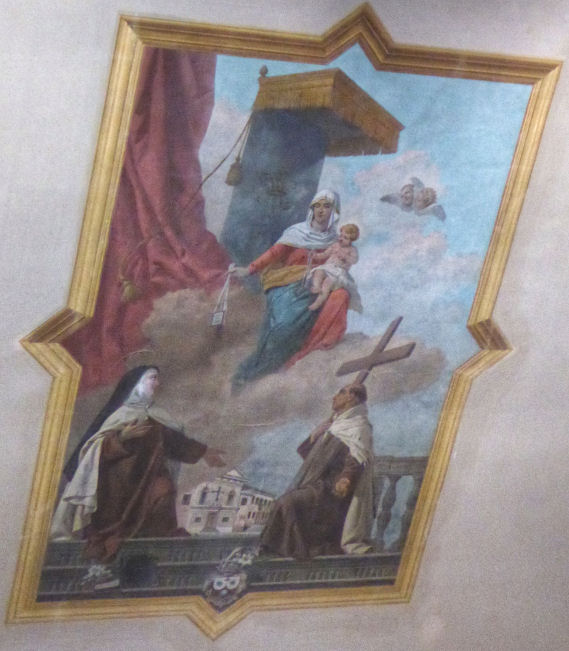 Interior Square and small and pale. There are two deepish side chapels, each with marble-surrounded painted altarpieces. A choir and apse with a bench around it. A ceiling panel over the nave (from the 18th century?) (see right) shows the Virgin and Child giving the scapula to a donor nun and Saint Simon Stock, the nun pointing to an image of church. Lost Art Works by Tintoretto and his follower Leandro Bassano, the third son of Jacopo, were to be found in the church before suppression. The Bassano is the Apparition of the Virgin to Saint Bonaventure which was the high altarpiece here, now in the Accademia, but not on display. Giovanni Battista Tiepolo's Santa Margherita di Cortona, once here, is now in San Michele in Isola. Opening times For services Vaporetto Sant’Alvise 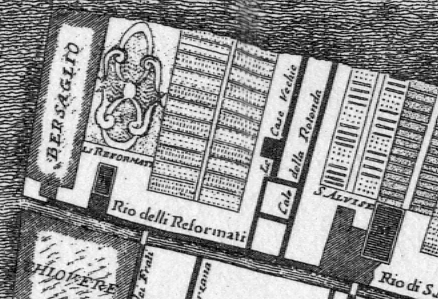 map
|
|
|
|
History Tradition has it that the first church on this site was built in 864 by refugees from Aquileia, but the earliest printed reference is dated 1041. The church is dedicated to Saints Canziano, Canzio, and Canzionello, two brothers and a sister who were martyred in Aquileia in 304, but Venetian dialect has blended them into one. The church was restored in the early 14th century and reconsecrated in 1351, with much rebuilding thereafter. The current church dates mostly from a rebuilding in the mid-16th century. The façade was built during rebuilding in 1706 by Antonio Gaspari, and paid for by Michele Tommasi whose bust is over the main entrance. Interior The church is usually entered by either of the two smaller doors opposite each other in the side walls of the bottom of the nave, which thereby form a sort of 'entrance corridor' effect at the very back of the church. These doors also let in a fair amount of the noise of the campo and the market stalls, adding to this church's feel of being open and used. The pale-pink walls balance 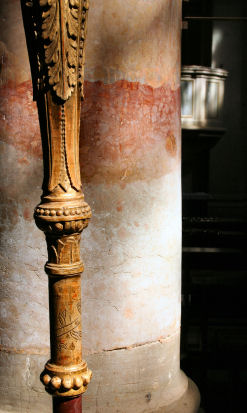 out some somewhat
dark and dingy paintings and the heavily-carved side chapels to make for a quietly quite pleasing
interior. The Widmann family chapel to the right of the chancel may be by
Longhena. out some somewhat
dark and dingy paintings and the heavily-carved side chapels to make for a quietly quite pleasing
interior. The Widmann family chapel to the right of the chancel may be by
Longhena.Art highlights There are altarpieces by Bartolomeo Letterini, Domenico Zanchi and Nicolò Renieri, amongst other equally lesser-known 18th-century artists. The high altarpiece shows The Glory of Saints Canzio, Canziano, and Canzianilla, attributed to Paolo Zoppo. It is flanked by The Pool of Bethesda and The Multiplication of the Loaves and Fish by Zanchi. There is also a chapel containing the sarcophagus, and a statue by Clemente Molli, of Saint Maximus of Turin. Campanile 24m (78ft) manual bells Restored in the 16th century, including replacement of the belfry. The church in art John Singer Sargent Leaving Church, Campo San Canciano, Venice 1882 (see below) Opening times Usually! 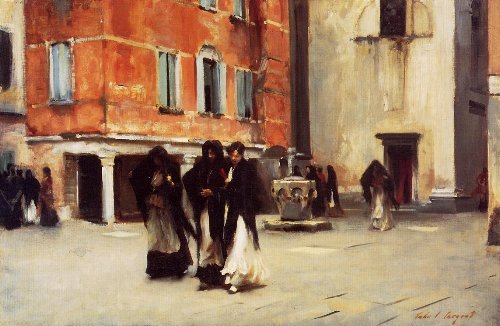 Vaporetto Ca d'Oro map
|
|
|
|
History Founded, it is said, in 966 by the Gallina family and dedicated to Saint Felix of Nola. The first documentary evidence is from 1133. After restoration it was consecrated in 1267. Danger of collapse led to the building of the present church with two façades in 1531, to a design reminiscent of Mauro Codussi's San Giovanni Grisostomo below. Reconsecrated in 1624. Closed by Napoleon and reopened as a parish church in 1810. Amongst the relics here are bones of Saint Felix and a clod of earth stained with Christ's blood. Interior A radical reworking of the interior in 1810 resulted in the replacement of the 16th-century altars with inferior modern examples, my guide book says, somewhat sniffily, but this church is actually an unexpected calm Istrian-stone Greek-cross gem on the inside, if you find it open. The chapel left of the presbytery has bones of Saint Tryphon, displayed on cotton wool in a glass-fronted box, he being the co-dedicatee of the scuola of San Giorgio degli Schiavoni and revered by the Eastern Orthodox church. There's also a plaque over the sacristy door commemorating Pope Clement XIII, who was baptised here in 29th March 1693 as plain Carlo Rezzonico. 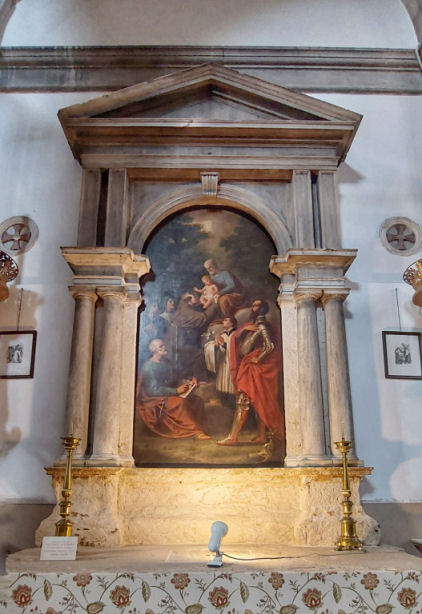 Art highlights There's an early Tintoretto, San Demetrio and Zuan Pietro Chigi in the corner chapel to the right of the apse, with the named donor large in foreground. Amongst the early 19th century paintings over the nave side altars is a painting by Lattanzio Querena of Saint Joseph with the Christ Child and Saints, which is unusual for having Joseph in the Mary role with the Child on his lap. The saints are (to the left) Anthony of Padua with, in the background, Lorenzo Giustiniani and Vincent Ferrer. The foreground trio is Saints Peter, Aloysius Gonzaga, and (the church label tells us) Oswald. The local parish did indeed have confraternity of Saint Oswald the Confessor, and whilst there are two English saints of this name one was a bishop and the other a king, usually portrayed wearing a crown, not armour. Also five figures carved by Giulio del Moro in the late 16th century. 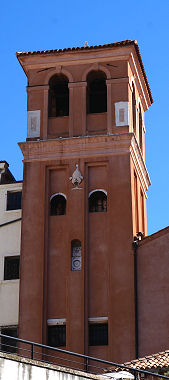 Lost art A Giovanni Bellini altarpiece which was commissioned by the Cinturari (guild of belt-makers) for this church is now lost. As is a painting of Saints Paul and Anthony Abbot by Gentile da Fabriano mentioned by Ridolfi in 1648. 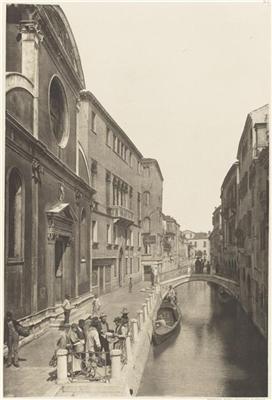 Campanile 22m (72ft) manual bells Not easily seen.
|
|
|
|
History Legend has it that the first church here was one of the eight founded by Saint Magnus in the 7th century, but a church built from 811 by the Malpiero family is less legendary. This latter building was demolished around 1040 and another church was then built, with the benefit of Mauro Tosello and his son Bartolomeo bringing the arm of Saint Bartholomew, which they'd purchased in Apulia, in 1043. The church was dedicated to the prophet Jeremiah, an Old Testament figure, like the dedicatees of several other Venetian churches, like San Giobbe and San Moise, reflecting the influence of the Orthodox church in Venice. Further rebuilding in 1174 under Doge Sebastiano Ziani, as the church had fallen into ruin, and reconsecration on the 1st of June 1292. Fra Bartolomeo Fonzio Veneziano preached here, before being accused of heresy and drowned at the Lido with a stone around his neck on the 4th of August 1562. The present Baroque church dates from a complete rebuilding, following demolition of the smaller 12th-century Romanesque church, by the Brescian priest/architect Carlo Corbellini from 1754. The first mass was celebrated on 27th April 1760, while this work continued. Famous bull hunts took place in Campo San Geremia, reportedly because the Spanish Embassy was nearby, but the many butcher's shops in the square, happy to take the bulls carcasses after the 'sport' may have been a factor. A report from one such event in the late-18th-century tells that that the dog handlers 'incited these frenzied quadrupeds to attack the enormous, defenceless bulls that were infuriated and tied to cables and pawed the ground, goring the air and any unfortunate person'. The church Two marble façades of similar design, completed in 1871 with the 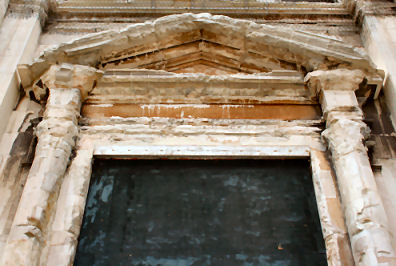 façade facing the Cannaregio canal, to replace those damaged by fire
following an Austrian bombardment in 1849. They were paid
for by Baron Pasquale Revoltella, who had been born in the parish and
baptised here. One
faces onto the campo (see far right) where the famous bull-hunt was held (possibly
due the proximity of the Spanish embassy, hence Lista di Spagna)
and is somewhat crowded on the left by the Palazzo Labia. The other one,
damaged by a mentally unstable arsonist who set fire to wooden scaffolding in
June 1998 and still being restored, faces the Cannaregio Canal (see detail
of damage right).
façade facing the Cannaregio canal, to replace those damaged by fire
following an Austrian bombardment in 1849. They were paid
for by Baron Pasquale Revoltella, who had been born in the parish and
baptised here. One
faces onto the campo (see far right) where the famous bull-hunt was held (possibly
due the proximity of the Spanish embassy, hence Lista di Spagna)
and is somewhat crowded on the left by the Palazzo Labia. The other one,
damaged by a mentally unstable arsonist who set fire to wooden scaffolding in
June 1998 and still being restored, faces the Cannaregio Canal (see detail
of damage right). The interior The church is entered from the campo San Geremia, and you actually thereby enter from the right-hand side. A Greek cross, quite bare with dark altars and minor, mostly 17th and 18th-century, art. There's a dome at the crossing and semi-domes at the end of each arm, the interior can best be described as dirty white walls with buff-coloured detailing. Saint Lucy's Relics A chapel off to the left, built in 1863, contains the 'partially incorrupt' body of the Sicilian Saint Lucy, looted by Enrico Dandolo during the Sack of Constantinople which marked the end of the shameful Fourth Crusade in 1204. It was moved here on the 11th of October 1860, and later placed in a chapel built betwen 1860 and 1863 here to house the reconstructed Palladio-designed Mocenigo chapel from the church of Santa Lucia when that church was demolished to make way for the railway station. The body has been in its current case since 1930. It was stolen again, from this church, on November 7th 1981 by two gunmen who dislodged the saint's head as they removed the body from its case. The body was found by the police a month later, on December 13th, in a hunting lodge. Saint Lucy's attribute in paintings is her eyes, usually on a plate, which she plucked out so as to make herself unattractive to a wealthy suitor. Her martyrdom is said to have come when her throat was cut, in 304, during Diocletian's persecutions. Her face is now covered by a relatively recent silver mask - until the 1960s you could still gaze into her empty sockets, but Pope John XXIII, when he was Patriarch of Venice, thought the sight too gruesome and ordered the mask be made. Her woody-looking hands and feet are still horribly visible however. Other remains the church possesses include bones of Saints Thomas and Bartholomew and a rib of Mary Magdalene. Also Saint Magnus of Oderzo (San Magno), the 7th-century saint who is supposed to have founded eight churches in Venice, is said to have been buried in this church. Art highlights Around eight works by Palma Giovane, including a half-length Saint Lucy and a Mary Magdalen, both taken from the church of Santa Lucia; a quite nice Annunciation on organ doors; and The Coronation of Venice by Saint Magnus, with the Virgin, the only painting remaining here from the 12th-century church, described in one guidebook as 'passable'. The remains of Saint Magnus were kept here from 1206, when the church where they had been placed in Eraclea was flooded, until 22nd April 1956 when they were returned to the church of Santa Maria Concetta in Eraclea. A sign promises a Tintoretto in a museum to the right of Saint Lucy's chapel but this seems now to be largely a gift shop. This work is a Virgin and Child with Saints Jerome and the young John the Baptist, or a Sacred Family, and is described as attributed. It looks very rough. 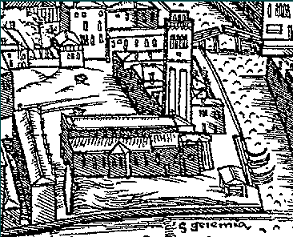 Campanile 43m 140 ft manual bells One of the oldest left in the city and all that remains of the 12th century church, topped by an octagonal tambour and balustrade that are probably a little later but are visible in Jacopo de' Barbari's map of 1500 (see right) which shows the 12th century church. The church in art The Grand Canal at the Entrance to the Cannaregio Canal by Michele Marieschi, painted in 1741-2 shows the old church. 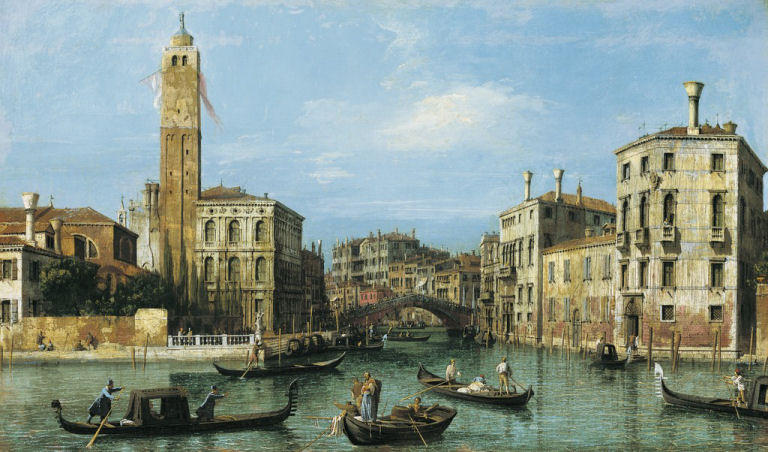
Fire on the Church of San Geremia by Luigi Querena, a night-time
view, commemorates the Austrian bombardment of 1849. |
A print from around 1717 showing the old church, and the
|
|
|
History A Franciscan oratory and hospice 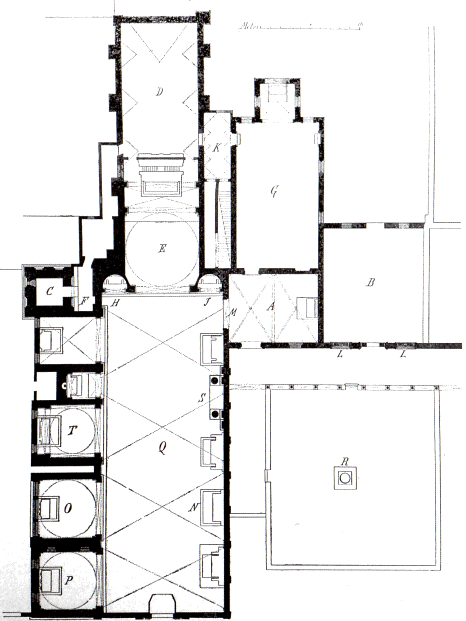 dedicated to the Old Testament
prophet Job (Giobbe,
or Sant'Agiopo in Venetian dialect) was founded here in
1378, funded by Giovanni Contarini, who lived nearby, and completed by his
daughter Lucia. In 1428 control passed from the Eremiti di San Girolamo to
Observant Franciscans, who added a convent. In 1443 Saint Bernardino of Siena preached here, so impressing future Doge Christoforo Moro that he
added the saint to the church's dedication and put up the money to build a new church in the preacher’s
honour, with work on the present church beginning in a gothic style in 1450
to designs by
Antonio Gambello. It is likely that the new church was at right-angles to
the old - the old church is reported to have faced the Cannaregio Canal. Very little of Gambello's work remains -
just the
gothic windows in the right nave wall, the exterior pilasters of the apse, the ante-sacristy (now
called the Contarini Chapel), the campanile and the remaining wing of
the adjoining cloister. In 1470 Pietro Lombardo was called in to finish the
work and this, his first architectural job in Venice, is one of the earliest examples of
Renaissance architecture in the city – the main doorway on the façade (see
photo right)
is an especial treat in a Florentine style. The three statues that stood
on the doorcase, by Pietro and Tullio, of Saint Louis of
Toulouse, Saint Bernardino of Siena and Saint Anthony of Padua
were moved to the chapel of Mula in the sacristy for conservation.
The church was consecrated in 1493. dedicated to the Old Testament
prophet Job (Giobbe,
or Sant'Agiopo in Venetian dialect) was founded here in
1378, funded by Giovanni Contarini, who lived nearby, and completed by his
daughter Lucia. In 1428 control passed from the Eremiti di San Girolamo to
Observant Franciscans, who added a convent. In 1443 Saint Bernardino of Siena preached here, so impressing future Doge Christoforo Moro that he
added the saint to the church's dedication and put up the money to build a new church in the preacher’s
honour, with work on the present church beginning in a gothic style in 1450
to designs by
Antonio Gambello. It is likely that the new church was at right-angles to
the old - the old church is reported to have faced the Cannaregio Canal. Very little of Gambello's work remains -
just the
gothic windows in the right nave wall, the exterior pilasters of the apse, the ante-sacristy (now
called the Contarini Chapel), the campanile and the remaining wing of
the adjoining cloister. In 1470 Pietro Lombardo was called in to finish the
work and this, his first architectural job in Venice, is one of the earliest examples of
Renaissance architecture in the city – the main doorway on the façade (see
photo right)
is an especial treat in a Florentine style. The three statues that stood
on the doorcase, by Pietro and Tullio, of Saint Louis of
Toulouse, Saint Bernardino of Siena and Saint Anthony of Padua
were moved to the chapel of Mula in the sacristy for conservation.
The church was consecrated in 1493.Church and convent were suppressed by Napoleon in 1810, and the convent demolished two years later. The grounds and vineyard were laid out as Venice's Botanical Gardens in 1812. Much damaged by Austrian bombardment, being so close to the mainland, the gardens reopened but closed in 1870. After more than three years of closure for restoration works the church reopened sporadically in late 2018. The interior Pietro Lombardo’s calm interior has chapels on the left side and used to have three major altarpieces (see Lost art below) on the right, and so large and impressive were they (complete with illusionist depth) that they balanced the depth of the real chapels on the left – a neat trick as the right hand side of the nave couldn’t have protruding chapels as it backed onto the existing cloister. The carved stone frames remain, including that for Bellini's painting (possibly carved by Pietro Lombardo himself, or if not by a talented assistant) with its characteristic dolphins, a detail repeated in the painting. The early renaissance style of the interior, with its decorated cupola, gives the church a bit of a Brunelleschi feel, which is only enhanced by the polychrome Luca della Robbia roundels in the vault of the very Florentine Martini Chapel, second on the left. They depict God the Father and the Four Evangelists. The bas relief Annunciation on the arch into the apse is more Lombardo work, as are the bas reliefs in the pendentives of the apse dome, depicting the Four Evangelists, with God the Father in the centre. There's a very deep counter-reformation retrochoir. Doge Christoforo Moro (reputed to have been the inspiration for Shakespeare’s Othello) and his wife Cristina Sanudo are buried in the church, whose building he largely funded. The date of his endowment - 1470 - is inscribed on his floor tomb. The Contarini Chapel, through a door to the right of the apse, is a remainder of Gambello's original building and contains a pleasing Nativity by Girolamo Savoldo from 1540, said by some to feature the donor painted as the lead shepherd, and by others have been over-restored. Beyond is the sacristy which has its original wood furniture and painted ceiling panels, by Baldassare delle Grottesche, showing Old Testament prophets and saints, and an Annunciation between Saints Anthony of Padua and the Archangel Michael by Antonio Vivarini from c.1447. The paintings here are all fairly ordinary, unfortunately. Lost art The three altarpieces mentioned above were Giovanni Bellini’s Virgin and Child with Saints Francis, John the Baptist, Job, Dominic, Sebastian and Louis of Toulouse (also known as The San Giobbe Altarpiece) painted between 1476 and 1484 (1476 being the year Antonello da Messina finished his altarpiece in San Cassiano, from which Bellini copied Saint Dominic), Vittore Carpaccio’s Presentation of Christ in the Temple (Purification of the Virgin) of 1510 (very visibly inspired in composition by the Bellini and in its integration with its stone frame) and Marco Basaiti’s Agony in the Garden. The Carpaccio was likely commissioned by Filippo Sanudo, the nephew of the above-mentioned Doge Cristoforo Moro. They must have been a pretty impressive sight, all in the same small church, but now they are the three highlights of the second room in the Accademia, hung on the wall opposite the bench and staircase in the same order that they appeared in the church (Carpaccio, Basaiti, Bellini). They were looted by Napoleon and returned to the Accademia in 1815. Their aching lack in San Giobbe only adds to the slightly forlorn feel of this church in this somewhat backwaterish part of Venice. The Bellini in particular loses out from being separated from its original frame, carved by Pietro Lombardo. See right for a photographic reconstruction of the Bellini altarpiece, a very early example of one painted to match its architectural frame. Job stands haloed and unclothed to the Virgin's immediate right, 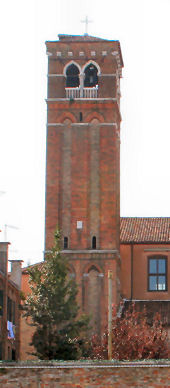 A Transfiguration of Christ by Giovanni Bellini, now in the Correr Museum, may have come from here or San Salvatore, as both churches are recorded as having had a Bellini depicting this scene. Campanile 46m (150ft) electromechanical bells Erected between 1451 and 1464, with restoration work in 1903, 1905 and 1982. The bells have a somewhat flat sound which can best be described as doinky. Ruskin wrote Its principal entrance is a very fine example of early renaissance sculpture. Note in it, especially, its beautiful use of the flower of the convolvulus. There are said to be still more beautiful examples of the same period, in the interior. The cloister, though much defaced, is of the Gothic period, and worth a glance. And he says that the Virgin and Child by Bellini is Alone worth a modern exhibition building, hired fiddlers and all. The third best Bellini in Venice, and probably the world. Opening times Monday, Tuesday, Friday, Saturday: 10.30 - 1.00 According to the pc-printed Chorus sign on the door. But, as ever, people are finding it closed when it should be open. A Chorus Church Vaporetto Ponte dei Tre Archi map |
|
|
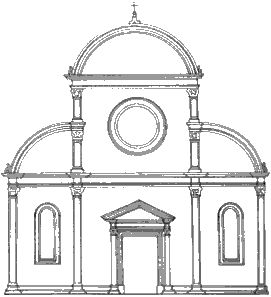 History HistoryThis church is one of the very few in Western Europe dedicated to the 4th-century patriarch of Constantinople, a Greek contemporary of Saints Ambrose and Augustine, reflecting the strength of the Byzantine influence in Venice when the first church on the site was built in 1080. John Chrysostom is one of the four Eastern Orthodox Fathers of the Church - chrysostom means golden-tongued. See below for one of his homilies. During his lifetime he had sought to preserve the unity of the Eastern and Western churches, and after the Latin conquest of Constantinople in 1204 he was made the patron saint of the Latin Patriarchate in Constantinople and most of his relics were removed to Rome. His homilies against Jews and homosexuality have made him a controversial figure, especially following his adoption by the Nazis. Thomas Aquinas is reported to have said that he would rather have a book by John Chrysostom than the city of Paris. The original church was demolished in 1495 after a fire. Work began on a replacement in 1497 to designs by Mauro Codussi. It was his last church in Venice and its façade is almost identical to his one for San Michele in Isola, which was his first, although more modest funding means that the façade here is mostly brick, with the stone detailing confined to the doorways. It shares the Greek cross plan of his Santa Maria Formosa, but is much more vertical due to the narrow site. Codussi died in 1504, but work here was completed by his son Domenico, with consecration in 1525. The façade was damaged during an air-raid in February 1918, and there'd also been a near miss on 13th September 1916 (see photo far below right). 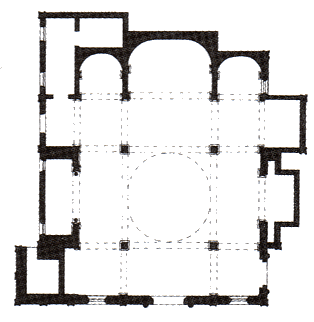 The interior The interior is compact, cosy and welcoming, but usually noisy from the crowd flow outside. A Greek cross plan ringed by apses, the pleasing proportions derive from Platonic ideals of perfect geometric form and balance. Codussi's original barrel vault over the choir was unfortunately replaced with a flat roof to help the lighting, but this remains one of those churches where darkness and unrestored paintings conspire to keep you squinting and a little frustrated. And talking of lighting - the light fittings bear an unfortunate but strong resemblance to condoms. Art highlights The altarpiece on the right as you enter is Giovanni Bellini's Saints Jerome, Christopher and Louis of Toulouse (see below right) hanging in the funerary chapel of merchant Giorgio Diletti who died in 1503. Signed and dated 1513, it's completion having been delayed by the rebuilding of the church, it was Bellini's last great innovative altarpiece. It's not as immediately striking as some of the mature-period gems in other churches in Venice, but it's characteristically serene and an odd space: just because Saint Jerome is outside in the wilderness, reading with his book propped on a handy fig tree, it doesn't mean that the other two saints have to suffer the elements too. Saint Louis is the saint for whom the church of Sant'Alvise was built. Some scholars have claimed that the bearded reading figure is Saint John Chrysostom and that the youthful bishop is Saint Augustine, but Dilletti's will stipulated the three saints to whom he desired his chapel be dedicated. The fact that he insited on three saints may be why this altarpiece lacks a Virgin, because a symmetrical composition with the Virgin, of course, in the centre would have been impossible. The gap in the composition at low centre encouraged someone in the church to fix a statue of Saint Anne to the centre of the painting in 1733 but was made to remove it by the Scuola di San 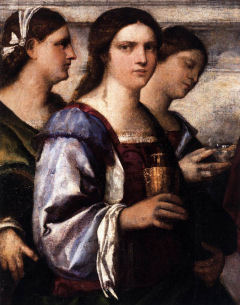 Marco, the confraternity of which Diletti was a member and had made patrons in his will
and which gave the commission to Bellini. The picture, which was
restored in 1976, is worn in places but the colours and light are
still special. It contains an inscription, derived from Psalm 13, which is
in Greek, reflecting Venice eastward-looking orientation. As does the
Byzantine arch.
Marco, the confraternity of which Diletti was a member and had made patrons in his will
and which gave the commission to Bellini. The picture, which was
restored in 1976, is worn in places but the colours and light are
still special. It contains an inscription, derived from Psalm 13, which is
in Greek, reflecting Venice eastward-looking orientation. As does the
Byzantine arch.Arguably influenced by the Bellini is the 1510/11 high altarpiece sacra conversazione here by Sebastiano del Piombo, of Saint John Chrysostom with Saints John the Evangelist, Catherine, Mary Magdalene, Lucy, John the Baptist, and an armoured saint (who might be George, Liberale or Theodore) the latter looking like a portrait. Henry James thought that the Magdalene looked like a 'dangerous but most valuable acquaintance' (see detail right). (She bares more than a slight resemblance to Sebastiano's Portrait of a Woman as a Wise Virgin in Washington, I think.) This is his only altarpiece remaining in Venice, and had been thought to be by Giorgione, thanks to Vasari's mistake in his first edition, corrected in the second. This Sebastiano/Giorgione confusion has continued into our own century with regard to many paintings, with added Titian attributions. It's one of those altarpieces that's better appreciated in photographs, though, because in situ it's not that easy to see. The Tullio Lombardo relief of The Coronation of the Virgin you can get close enough to, though, and it's very fine. Lost art Sansovino says that Sebastiano del Piombo painted the cupola here, but this work has never been found, despite a recent restoration of the church removing fourteen layers of plaster hoping to find it. Saintly behaviour? The penance of Saint John Chrysostom became a popular theme in German art in the late 15th century, around the time this church was being rebuilt. There are prints by Dürer and Cranach, but the legend was later mocked by Luther. The story tells of how the young John took to the wilderness to become a hermit. An emperor's daughter, gathering flowers nearby, was swept by a wind to the mouth of John's cave where she asks for shelter. He takes her in, dividing the cave into two parts, but succumbs to carnal desire and has sex with her. He is then so racked with shame that he throws her over a cliff. Consumed with regret he wanders the wilderness like a beast, naked on all fours and eating roots and grass. Fifteen years later he discovers that the emperor's daughter is still alive and living in the wilderness, having borne his child, who miraculously declares his sins forgiven. Saint John Chrysostom said It is foolishness and a public madness to fill the cupboards with clothing and allow men who are created in God’s image and likeness to stand naked and trembling with cold, so that they can hardly hold themselves upright. Yes, you say, he is cheating and he is only pretending to be weak and trembling. What! Do you not fear that lightning from Heaven will fall on you for this word? Indeed, forgive me, but I almost burst from anger. Only see, you are large and fat, you hold drinking parties until late at night, and sleep in a warm, soft bed. And do you not think of how you must give an account of your misuse of the gifts of God? 21st homily on 1 Corinthians
Ruskin said |
|
|
History A convent with a small oratory was founded here in 1375 by two Augustinian nuns, Bernarda Dotto and Girolama Lero, originally from Santa Maria degli Angeli on Murano. They had fled from Treviso, escaping the invading Hungarians lead by King Lajos. Later 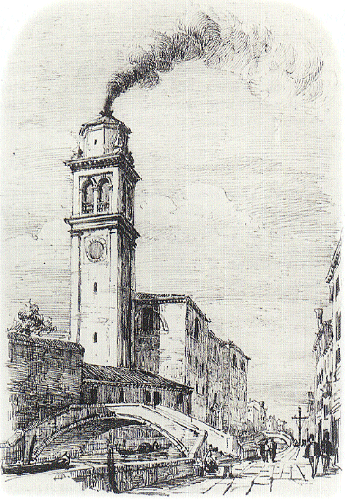 that century the convent was enlarged and a church built. This work was
completed in 1425 but in 1456 these buildings
were damaged by fire, which resulted in more rebuilding and further
enlargement.
that century the convent was enlarged and a church built. This work was
completed in 1425 but in 1456 these buildings
were damaged by fire, which resulted in more rebuilding and further
enlargement. The present church dates from the rebuilding by Domenico Rossi in the early 18th-century (following destruction in yet another fire in 1705) with interior decoration by Francesco Zugno. The new church was reconsecrated on the 15th of June 1751. Both church and convent were suppressed by the French in 1807. From 1840-1855 the church was used as the steam mill of a sugar refinery installed in the convent and a chimney was installed in the campanile (see right). It's also said to have once been used as a brick factory. The church was restored and reopened in 1952, (see black & white pre-restoration photos far below which show evidence of much adjustment to doors and windows). Interior Tall, bare, white-walled and aisleless with much rising-damp crumble at base of walls. Four confessionals towards the back. 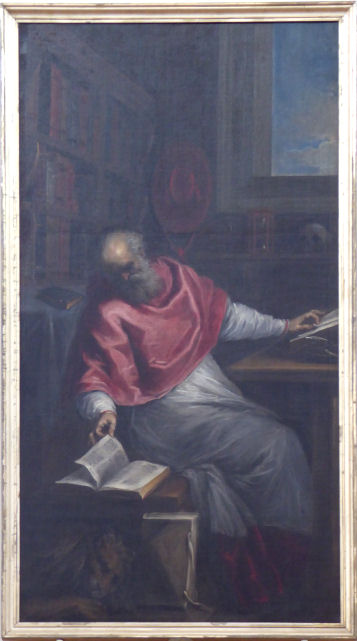 Art Some small painted panels including a quite nice Saint Jerome in his Study by Palma il Giovane (see right) of c.1590, originally painted for the albergo of the Scuola San Fantin but here since 1958. Also on the right side of the nave is an action-packed Ascension. A long panel on the left wall of the choir, with a smaller Last Supper on the right wall. Some dingier ones on the left side of the nave. Lost art The Holy Father Blessing by Pier Maria Pennacchi (previously thought to be by Alvise Vivarini) came from the ceiling of the oratory of the Scuola di San Girolamo (now demolished), which was behind the church. The panel was still in situ in 1843, but was removed shortly afterwards and passed into private hands. Bought by the Accademia in 1899 for 1,000 lire. It has been installed in the centre of the carved wooden ceiling of gilded cherubim in Room 1 there. The Scuola also had two scenes from the legend of Saint Jerome by Giovanni Bellini which are now lost. Campanile Was demolished when it became unsafe, but still visible in the photo taken at the end of the 19th century (see below). 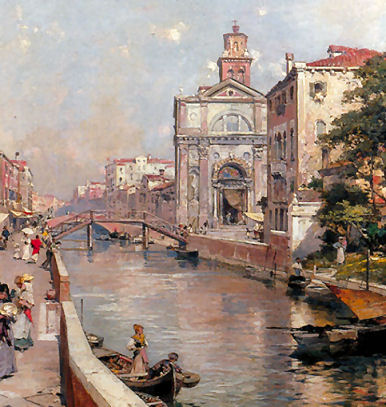 The church in art The Tate Gallery has a sketchbook with a drawing of the campanile by Turner. Rio St. Geronimo by Franz Richard Unterberger (detail right) shows the church in the 19th century with its campanile, but without the wall now enclosing the campo in front of the façade. Opening times Only open for services. (Tues 5.00, Thurs 5.00, Sun 11.30) I got lucky on a Sunday morning as the priest was preparing (see photo right). Vaporetto Ponte dei Tre Archi map |
|
|
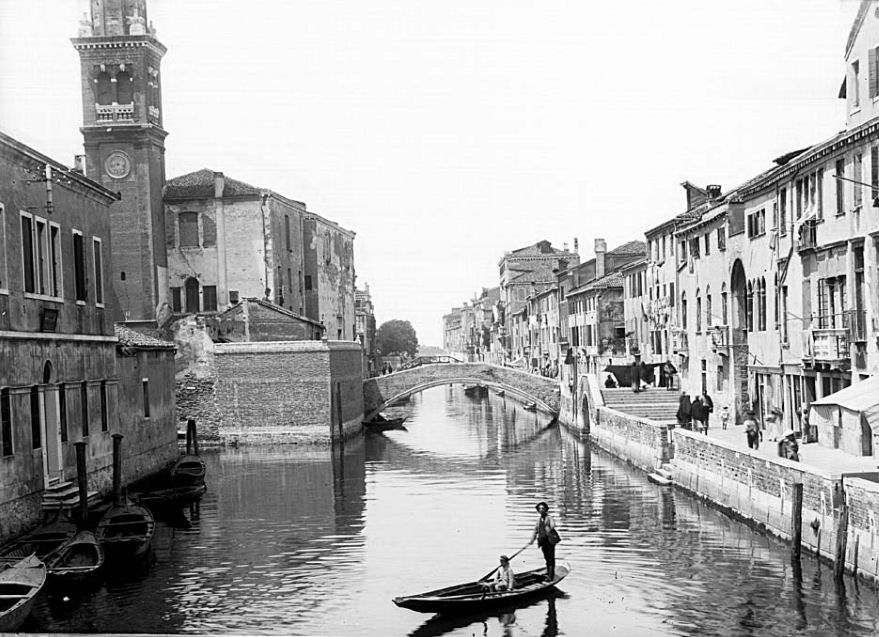
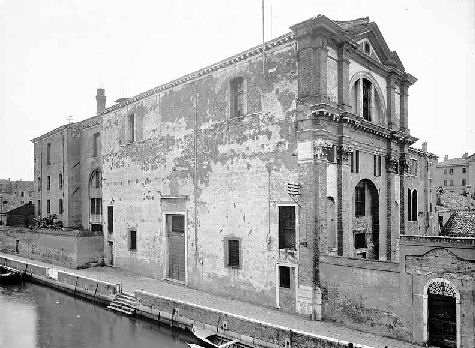 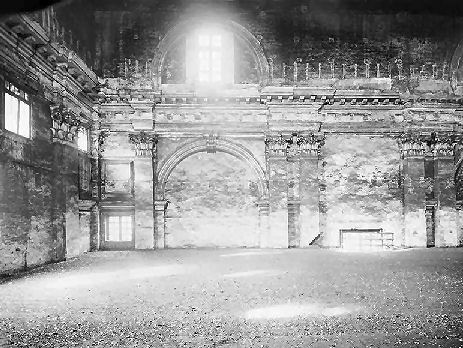 |
||
|
History Built in 1025, with the help of the Crituazio family, but first documented in 1089. Restoration in the early 14th century resulted in reconsecration in 1343. In 1260 the Scuola di Santa Maria della Carità, the first Scuola Grande, was founded here. It later moved to the complex of Santa Maria della Carità which is now part the Accademia Galleries. The current church here dates from a rebuilding of 1794 by Bernardino Maccaruzzi, a pupil of Giorgio Massari, brought about by the parlous state of the old church. It was suppressed by the French in 1807, having since been used as a coal warehouse and for band practice. It has been a community centre too and now, still owned by the Comune di Venezia, houses exhibitions and meetings. Interior An airless nave, almost nothing remains of the internal features of the church, just sparse moldings, capitals and a couple of door cases. Lost art Zanetti in 1773 reports a Resurrection of Christ by Aliense (Antonio Vassilacchi) over the main altar on the left. Also a San Carlo by Domenico Tintoretto, and a Saint Anthony by Lazarini. An Agony in the Garden and Christ Carrying the Cross by Bonifazio de 'Pitati flanked the high altar, Campanile Detached, it fell down on the 24th August 1595, damaging 12 houses and part of the church and killing 10 people, but still visible on the Merian map of 1635 (see below) which also shows the old church. Opening times For exhibitions and meetings. Update April 2023 Closed, after being used for a while as a COVID vaccination centre, see photo right. Vaporetto San Marcuola 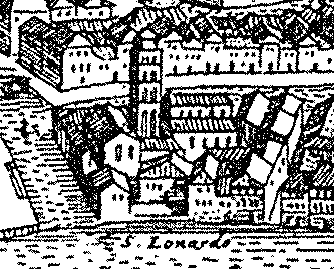 map
|
|
|
|
History Legend has a church here since 569, dedicated to Saints Ermagora and Fortunato, the two protomartyrs from Aquileia, who were disciples of Saint Mark. This naming became, by the mysterious workings of the Venetian dialect, San Marcuola. The first documented mention is from 1069. The church was famous for housing the right hand of John the 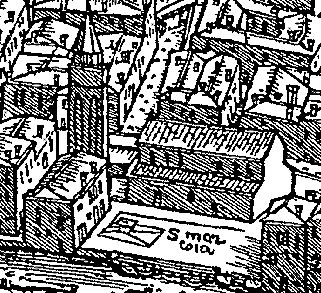 Baptist - the one with which he'd baptised Christ. Rebuilt after a fire,
which was caused by an earthquake, and
reconsecrated in 1343. Barbari's map of 1500 shows the
church
perpendicular to the Grand Canal with the apse to the north (see
right). This church
also
had a hermit's cell over the door in which three (and later
six) women were walled up. They moved to the church of the
Eremite when San Marcuola
became unstable and needed to be
rebuilt. This work began in 1663 first with the chancel, and then the rest of
the church, orientated parallel to the Grand Canal
this time, with the apse to the east. The architect was Giorgio Gaspari,
who died in 1730, after which the work was completed by Giorgio Massari.
Funding in 1727 had been raised by the Council of Ten authorising a
lottery.
Baptist - the one with which he'd baptised Christ. Rebuilt after a fire,
which was caused by an earthquake, and
reconsecrated in 1343. Barbari's map of 1500 shows the
church
perpendicular to the Grand Canal with the apse to the north (see
right). This church
also
had a hermit's cell over the door in which three (and later
six) women were walled up. They moved to the church of the
Eremite when San Marcuola
became unstable and needed to be
rebuilt. This work began in 1663 first with the chancel, and then the rest of
the church, orientated parallel to the Grand Canal
this time, with the apse to the east. The architect was Giorgio Gaspari,
who died in 1730, after which the work was completed by Giorgio Massari.
Funding in 1727 had been raised by the Council of Ten authorising a
lottery.Giustiniana Wynne was baptised here. She being the Venetian-born daughter of an English duke and a writer, famous for her friendships with Casanova and (more scandalously) the patrician Andrea Memmo. Her life and affair with the latter being the subject of Andrea Di Robilant's book A Venetian Affair. The 18th-century German composer Johann Adolph Hasse is buried here. He spent the last 10 years of his life in Venice, during which time he composed sacred music and served as chorus master at the Ospedale degli Incurabili. Hasse was a friend and colleague of Silvius Leopold Weiss, the last great composer for the lute, and a composer for the lute himself. F. S. Kandler revived the composer's name with a biography in 1820 and paid for Hasse's gravestone here.
The church |
|
|
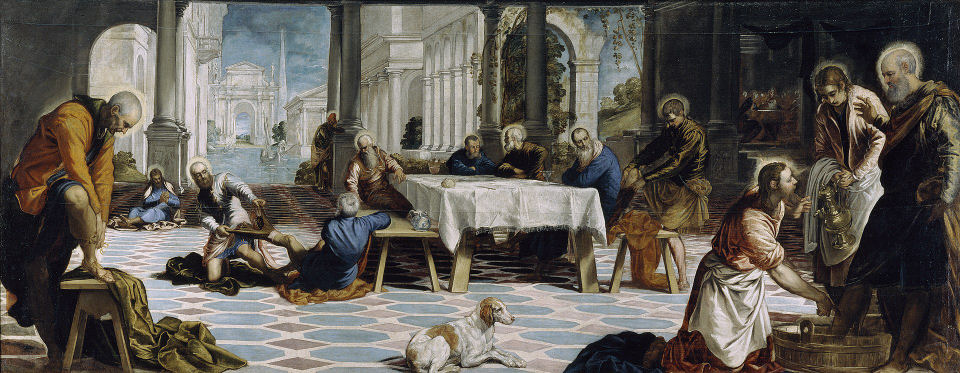
Continued on
Cannaregio page 2
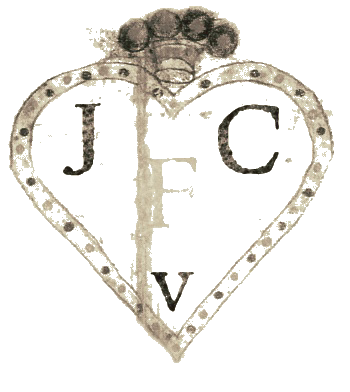
Home
Cannaregio ::
Castello ::
Dorsoduro ::
Giudecca ::
San Marco ::
San Polo ::
Santa Croce
:: The Islands ::
Demolished
Padua
:: Verona :: Bologna